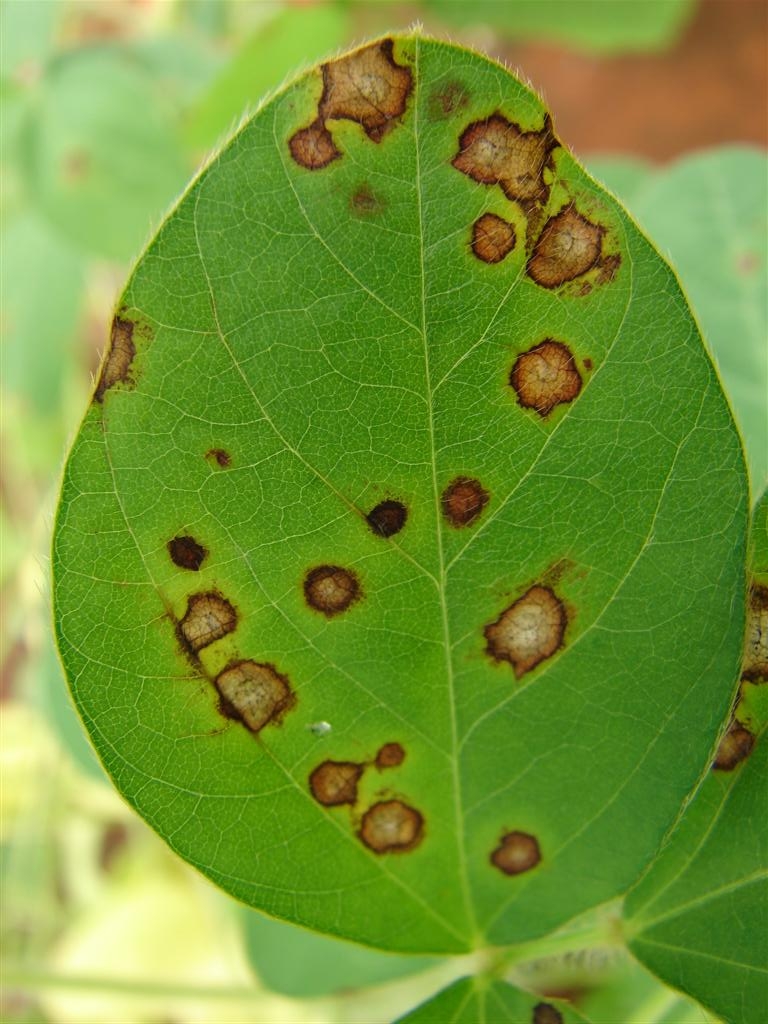What to Watch For
Frogeye leaf spot (FLS) is caused by the fungus Cercospora sojina. Distribution of this fungal pathogen was once limited to the southern United States but now reaches as far north as Canada. The disease occurs most commonly in the warmer regions of the country when conditions are warm and humid.1,2 Risk of FLS is greatest when soybeans are grown continuously in the same field, especially in reduced tillage situations. The pathogen overwinters on soybean residue and seeds. Warm, humid weather promotes spore production, infection, and disease development. Spores are readily transported from one field to another by wind.
The risk for FLS is greater when:
Planting a susceptible soybean product in a field with a history of FLS.
Fields are under continuous soybean production (no crop rotation).
Fields have short rotations between soybean crops.
- Fields in conservation tillage or no-till production systems.
Identification and Scouting
 Figure 1. Frogeye leaf spot lesions may coalesce to form irregularly-shaped necrotic areas.
Figure 1. Frogeye leaf spot lesions may coalesce to form irregularly-shaped necrotic areas.
 Figure 2. Classic lesion symptoms with light-gray center and purple to brown margins.
Figure 2. Classic lesion symptoms with light-gray center and purple to brown margins.
Planting infected seeds results in early-season infection and stunted seedlings. Although symptoms may begin at this early stage of development, FLS most oftenly occurs after flowering. Scouting should begin around the flowering stage (R1) if pathogen-free seed was planted in the field.
Lesions appear initially as small, dark spots on the leaves. The spots are angular with light-gray centers and distinct purple to red-brown margins. Spots may coalesce to form larger, irregularly-shaped spots (Figure 1). Fruiting structures of the pathogen develop on lesions on the underside of the leaf, and conidia (infecting spores of the fungus) are produced in these structures. Small, dark hairs (seta) also form in these fruiting structures and can be seen using a hand-lens (Figure 2). Spores (conidia) are produced from leaf lesions and (are carried to neighboring plants on air currents and by splashing water. Additional infections continue as long as weather conditions remain conducive. Newly expanding leaves are the most susceptible to infection. Lesions on pods and stems appear reddish brown and darken as they mature but lack the characteristic gray-colored center. Lesions on pods may appear sunken, and the seeds inside the pods may turn brown and have cracked seed coats.
Yield Effect
The effect of frogeye leaf spot on yield potential can vary greatly depending on disease timing, soybean product susceptibility, and weather conditions during the reproductive stages. If the disease begins late in reproductive stages (after the R5 growth stage) or disease severity is low, the impact on yield is expected to be minimal. However, if conditions are favorable and there are severe disease outbreaks early in the season or just after flowering, yield losses can be as high as 35%.4
Tips to Manage
Cultural practices can be used to manage FLS over the long term. When disease is severe, tillage can be used to bury infested residue. Rotating away from soybean for two years allows more time for inoculum in the field to degrade before soybean is planted again.3
To manage FLS in-season, begin by planting the pathogen-free seed of a product with FLS resistance. The presence of FLS in the south has led to the development of many soybean varieties in maturity groups V and higher that have FLS resistance.3 For fields planted with susceptible varieties and with high disease pressure, yield potential can be protected by a foliar fungicide application. Thresholds for fungicide recommendations vary by region, but fungicide application should be considered when 1 to 2 lesions are found every 25 feet of row at soybean growth stage R2.2 A forecast of 77 to 86°F with prolonged dew or light rain favors disease development and would further justify fungicide applications.5
Strobilurin-resistant strains of the FLS fungus have been reported in several southern states, rendering Group 11 (strobilurins) fungicides ineffective at controlling these strains.6 Delaro® 325 SC fungicide is labeled for frogeye leaf spot and includes both a strobilurin and a triazole active ingredient from Group 3 for an additional mode of action. Delaro® 325 SC fungicide can be sprayed at early flowering or prior to disease development and for a 10- to 21-day interval where conditions favor disease development. To learn more about Delaro® fungicide, please visit https://www.cropscience.bayer.us/products/fungicides/delaro and contact your retailer. It is important to check with your local Extension agent for application timing and fungicide recommendations in your region.
Sources
1Jardine, D.J. 2020. Frogeye leaf spot. Soybean research and information network. http://soybeanresearchinfo.com
2Dorrance, A. and Mills, D. 2011. Frogeye leaf spot of soybean. The Ohio State University Extension. AC-53-10. http://ohioline.osu.edu
3Westphal, A., Abney, T., and Shaner, G. 2006. Frogeye leaf spot. Purdue University Extension. BP-131-W. www.extension.purdue.edu.
4Mueller, D. 2018. Mueller’s top 3 soybean diseases of 2018. Iowa State University. https://crops.extension.iastate.edu
5Faske, T. 2016. Soybean disease update and management: Frogeye leaf spot. University of Arkansas. http:www.arkansas-crops.com.
6Reese, M. 2020. Will fungicide resistant frogeye be an issue for Ohio in 2020? Ohio’s Country Journal. Ohio Ag Net. https://www.ocj.com/
Web sites verified 5/15/2020
6003_S8
